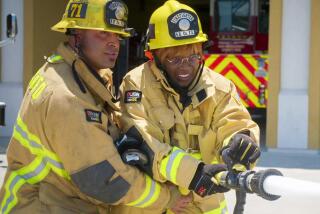Sweeps! Hold the News and Perk Up the Ratings : Television: Quick! A breaking story! But ‘chaos in the streets’ ends up just a ‘generally peaceful’ labor protest.
It’s Thursday. What you’re watching is not important in itself, but it’s significant as a metaphor for the type of behavior dictated by the May ratings sweeps that are now in progress.
KCBS-TV Channel 2 ends its 5 p.m. news with reporter Will Spens high above Los Angeles in “Chopper 2” doing a live wrap-up of the opening segment of his electrifying news series “Chopper Wars.”
Before going to a commercial, Channel 2 advertises that a “breaking story” will head its 6 p.m. news, but it doesn’t identify the story.
Anchor Bree Walker opens the 6 p.m. newscast, introducing that “breaking story.” There’s “chaos in the streets!” she reads from the TelePrompTer, breathlessly. “Hundreds of people are storming the streets downtown!”
Uh oh. Gangs. Violence. Bloodshed. Casualties. Break out the camcorders. Frightening possibilities run through your mind.
But no. As it turns out, the story concerns a protest by employees of luxury hotels. Again, cut to Spens, still flying high in “Chopper 2.” “The situation is generally peaceful,” he reports about the demonstration scene on the ground, captured from above by the helicopter’s camera.
On Channel 2, obviously, “generally peaceful” equals “chaos” and “storming” when the intent is to grab viewers’ attention. And “chaos” and “storming” equal ratings.
At 11 p.m., Channel 2 updates the story, with reporter Saida Pagan saying that 500--not the 1,000 originally cited by Spens--took part in the protest. “The height of the rally came when 35 workers sat in the street and linked hands,” she reports. Held hands while storming? Not quite. A police officer adds that the protesters “were a very orderly group.”
Making them all the more unruly and chaotic.
Even more significant than the deceptive, overcooked headlines read by Walker was the way the protest story was initially held back as a come-on for the 6 p.m. newscast, just as local stations use prime-time news breaks to air headlines--”Famous actor dies, story at 11”--that titillate instead of inform. What, no name? Naturally not. That would ruin the surprise.
Channel 2 is hardly alone when it comes to manipulating newscast viewers unethically, especially during ratings sweeps months, when competition is most intense. KABC-TV Channel 7 has been a notorious offender, for example. And KNBC Channel 4--in a gambit started before sweeps to entice viewers to watch during sweeps--has been deploying weathercaster Fritz Coleman and sportscaster Fred Roggin at Universal Studios during the station’s 11 p.m. newscasts. While clowning there, they string viewers along by referring to some vague giveaway, saying they’ll provide details “later.” So, night after night, stay with us.
In television’s ratings-mad milieu, withholding news frequently gets precedence over reporting news.
If the hotel employees’ demonstration was such a significant “breaking story,” it would have made journalistic sense to have Spens report it while airborne near the end of the 5 p.m. news instead of the station using the “breaking story” tag as a tease for the 6 p.m. newscast. Rather than illumination, however, Channel 2’s first priority was to hold onto its 5 p.m. audience.
Business is business.
SAY WHAT? KCBS anchors reportedly have been ordered to cap stories from the field by making a personal comment in the studio. Co-anchors Michael Tuck and Bree Walker have crafted this policy into comic art. Some examples of their meaningless tags, maliciously taken out of context:
Tuck: “They are pointing fingers fast and furiously.”
Walker: “Again, another news day developing.”
Tuck: “Terrible story.”
Walker: “Makes sense to me.”
Tuck: “That’s it, right there.”
Walker: “Tears in my eyes just imagining it.”
And this terrifying, ultimate threat from Tuck: “We’ll come right back.”
MIXED MESSAGE: The amazing ratings strength of that 24-year-old CBS behemoth “60 Minutes” speaks for itself. Topping the Nielsens in three decades amounts to a rather eloquent success statement by a series that throughout its history has been television’s most consistently entertaining and arresting hour of prime time. You may not always love it, but you rarely leave it.
However, there’s a down side to this programming triumph.
While chiseling itself into stone and becoming the catalyst for scores of news magazine imitations across the country through the years, “60 Minutes” has hastened the demise of that grand TV tradition, the long-form network news documentary.
“60 minutes” and its numerous format facsimiles--from ABC’s “20/20” to television’s corrosive tabloid club--have accustomed viewers to receiving so-called in-depth information in nibbles, telling in 15 minutes or so the stories that long-form documentaries used to tell in 60.
Or so we’ve come to think. Some of these programs meet a need. Yet even the best of them deliver mostly abridgments, relatively tiny explorations of topics that often demand something greater.
With the stories in regular newscasts also shrinking--along with news budgets--this is clearly an age of headlines taking precedence over thoughtfulness. TV fractured our attention spans, and now accommodates them.
Except on PBS, long-form documentaries have now become television’s most-endangered species. And even “60 Minutes”--with its storytelling skills honed over 24 years--doesn’t fill the void.
More to Read
The complete guide to home viewing
Get Screen Gab for everything about the TV shows and streaming movies everyone’s talking about.
You may occasionally receive promotional content from the Los Angeles Times.






